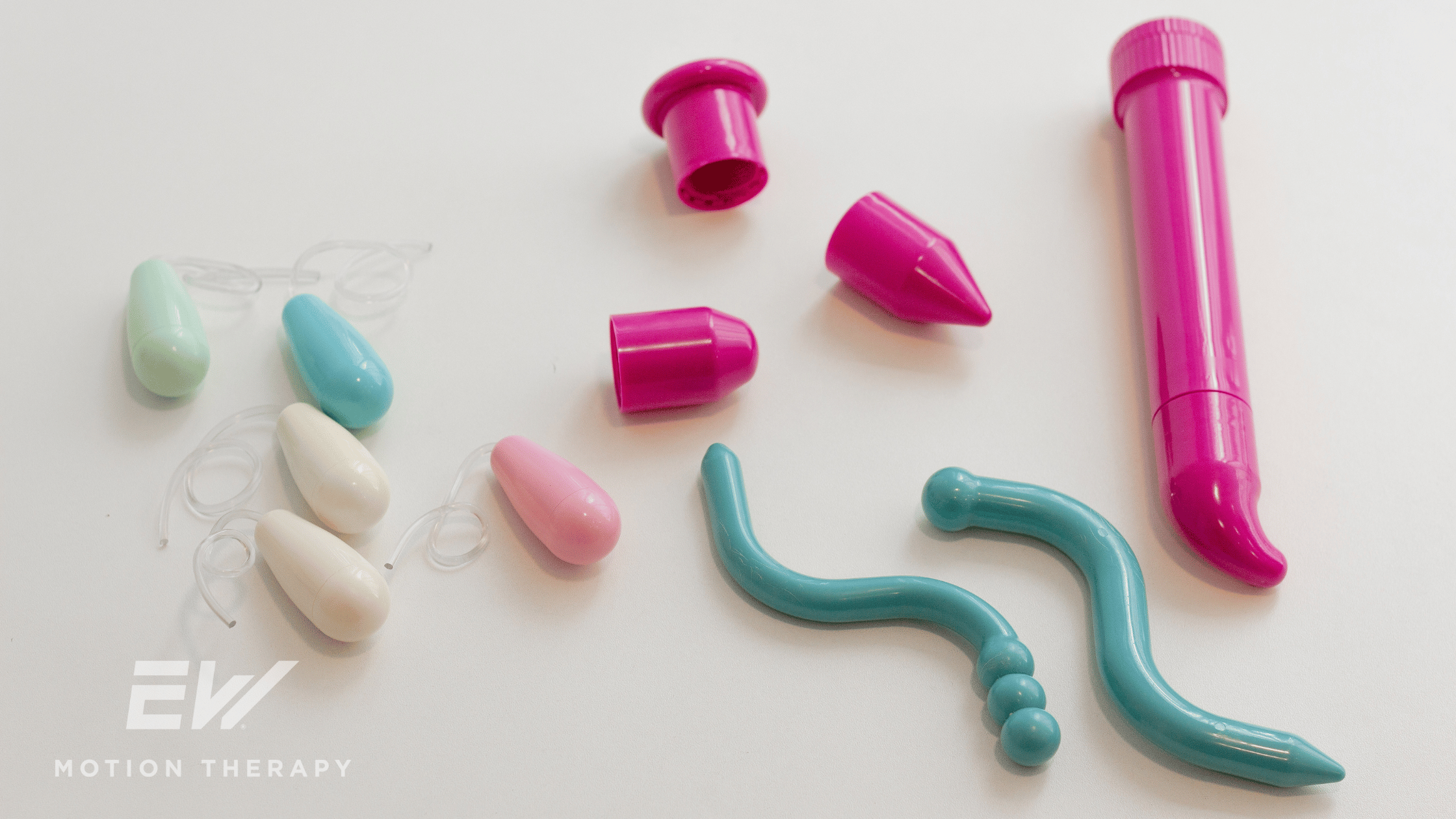Tools Used in Pelvic Floor Physical Therapy: Benefits and Patient Education

Licensed Physical Therapist, PT, DPT // OCS Orthopedic Certified Specialist // Certified Dry Needling Specialist // EW Motion Therapy Homewood
Pelvic floor physical therapy is a specialized field focusing on the muscles, ligaments, and connective tissues that support the pelvic organs. Various tools and techniques can be employed to address a range of conditions, from pelvic pain to incontinence. Our women’s health team at EW Motion Therapy is trained to use tools to help patients relax their pelvic floor and reduce pain. This article explores some of the tools our team uses the most in pelvic floor physical therapy, including pelvic wands, dilators, lubricants, cupping sets, SI belts, and vaginal weights. We will discuss the use and benefits of each tool, what to do if you do not wish to use tools, and how physical therapists educate patients on their proper use.
First, do I have to use tools?
While pelvic floor physical therapy tools can offer myriad benefits, they might not be right for everyone. Some patients may prefer to use their hands for mobilization and to practice relaxation techniques, especially if the thought of using tools causes anxiety or discomfort. You can always discuss your opinions and needs with your physical therapist, and they can adapt your treatment plan to include whatever makes you the most comfortable.
Other treatment options may also be included if other body regions contribute to your pelvic floor issues. Pilates balls, resistance bands, foam rollers, and stability balls can externally target specific areas, and dry needling can target dysfunctional trigger points at the source. Your physical therapist will adjust your treatment plan to include the modalities they believe are best for your needs.
Six common pelvic floor physical therapy tools
Pelvic wands
Pelvic wands are curved, often silicone or plastic tools designed to help individuals reach and massage the pelvic floor muscles internally. They are beneficial for releasing trigger points and alleviating muscle tension.
The primary benefit of pelvic wands is their ability to target hard-to-reach areas of the pelvic floor. They can be used to:
- Relieve pelvic pain
- Reduce muscle spasms
- Improve flexibility and muscle tone
- Enhance sexual function
Physical therapists guide patients in using pelvic wands effectively and safely. They demonstrate the correct positioning and movement techniques and provide instructions on identifying and releasing trigger points. Emphasis is placed on gentle and gradual use to prevent discomfort or injury. Intimate Rose has pelvic wands that we recommend to our patients.

Dilators
Dilators are graduated cylindrical tools used to stretch the vaginal or rectal tissues. They come in various sizes and are made of silicone or plastic.
Dilators are beneficial for:
- Treating vaginismus or dyspareunia (painful intercourse)
- Post-surgical rehabilitation
- Increasing tissue flexibility and elasticity
- Gradual desensitization and reduction of pain
Physical therapists provide a step-by-step approach for using dilators, starting with the smallest size and gradually increasing as comfort improves. They teach relaxation techniques and the importance of using lubrication to enhance comfort. Patients are also educated on the frequency and duration of use to achieve optimal results. Our therapists like the dilators from Intimate Rose, pictured below.

Lubricants
Lubricants are substances designed to reduce friction during various pelvic floor exercises and the use of tools like dilators and pelvic wands. They come in water-based, silicone-based, and oil-based formulations.
Lubricants offer several benefits, including:
- Reducing discomfort during exercises and tool use
- Enhancing the effectiveness of pelvic floor therapy
- Preventing tissue irritation and microtears
Physical therapists recommend appropriate types of lubricants based on individual needs and sensitivities. They explain how to apply lubricants effectively and discuss the importance of choosing products free from irritants and allergens. Our pelvic floor physical therapists often recommend coconut oil as an effective lubricant, and brands like Good Clean Love and Slippery Stuff offer fragrance-free options.
Cupping sets
Cupping sets consist of silicone suction cups applied to the skin to create a vacuum effect. This technique promotes blood flow, reduces muscle tension, and alleviates pain.
Cupping can benefit pelvic floor therapy by:
- Improving circulation and oxygenation of tissues
- Reducing muscle stiffness and pain
- Enhancing mobility and flexibility
- Promoting relaxation and stress relief
- Gently mobilizing cesarean scars in later stages of healing
Physical therapists instruct patients on the safe use of cupping sets, including placement and duration. They highlight the importance of monitoring for skin reactions and guide integrating cupping into their overall treatment plan—multiple reasonably-priced cupping sets are on Amazon, like the one pictured below.

SI belts
Sacroiliac (SI) belts are supportive braces around the hips to stabilize the sacroiliac joint. They are commonly used for SI joint dysfunction and pelvic girdle pain.
SI belts offer several advantages, including:
- Providing support and stabilization to the SI joint
- Reducing pain and discomfort
- Enhancing posture and alignment
- Allowing for improved mobility and activity levels
Physical therapists demonstrate how to wear and adjust SI belts for optimal support. They discuss when and how long to wear the belt and emphasize the importance of combining it with exercises and other therapeutic interventions. Our physical therapists like the SI belts from Serola, pictured below.

Vaginal weights
Vaginal weights are small, weighted devices inserted into the vagina to strengthen the pelvic floor muscles through resistance training, like Kegel exercises. They come in various weights and sizes.
The use of vaginal weights can:
- Improve pelvic floor muscle strength and endurance
- Enhance bladder control and reduce incontinence
- Increase sexual satisfaction and pelvic health
Physical therapists guide patients on the proper insertion, use, and progression of vaginal weights. They provide personalized exercise routines and stress the importance of consistent practice and gradual weight increase. Overuse of vaginal weights can lead to increased pelvic tension, so if you have pelvic pain or tightness, vaginal weights would likely not be the best intervention for you. If you do want to try vaginal weights to strengthen your pelvic floor, we recommend the set pictured below from Intimate Rose.

What to do if you feel uncomfortable with a specific tool
First, before you buy your own tools to use during your treatment, your physical therapist will assess your symptoms and needs to ensure they recommend the right tools for you. It's not uncommon for patients to feel uncomfortable or uneasy with certain pelvic floor therapy tools. Comfort and trust are essential for effective therapy, and physical therapists are trained to address these concerns.
Communicate your discomfort
The first step is to communicate your discomfort to your physical therapist. They can offer modifications or alternative tools that may be more comfortable for you. Open and honest communication helps ensure your therapy is tailored to your needs and comfort levels.
Explore alternatives
If a particular tool causes discomfort, there are often alternatives available. For example:
- If dilators are uncomfortable, your therapist might suggest starting with a smaller size or using a different material.
- If pelvic wands are challenging to use, alternative techniques like manual therapy or external massage may be considered.
- If cupping feels too intense, your therapist might recommend a gentler approach or different placement.
Additionally, as we discussed, you do not have to use tools for effective pelvic floor physical therapy. Your therapist can teach plenty of mobilization techniques that do not require tools.
Focus on relaxation techniques
Relaxation techniques can sometimes mitigate discomfort. Physical therapists can teach methods such as deep breathing, progressive muscle relaxation, or mindfulness to help ease tension and make the use of specific tools more comfortable.
Gradual progression
Sometimes, discomfort arises from using a tool too quickly or aggressively or not using enough lubricant. Your therapist can guide you on a more gradual progression, allowing your body to adapt slowly and reduce any potential discomfort.
Pelvic floor physical therapy utilizes various tools to address each patient’s needs. Pelvic wands, dilators, lubricants, cupping sets, SI belts, and vaginal weights each offer distinct benefits that contribute to overall pelvic health. Physical therapists play a crucial role in educating patients on the safe and effective use of these tools, ensuring that therapy is beneficial and empowering. By correctly understanding and utilizing these tools, patients can significantly improve their pelvic floor function and quality of life.
If any tool causes discomfort, you must communicate with your therapist, explore alternatives, and focus on gradual progression and relaxation techniques to ensure a comfortable therapy experience. Our women’s health team at EW Motion Therapy prioritizes patient comfort above all else, and they will ensure you are educated and confident in your treatment plan. To learn more about women’s health physical therapy, click the button below to download our answers to 20 frequently asked questions.


